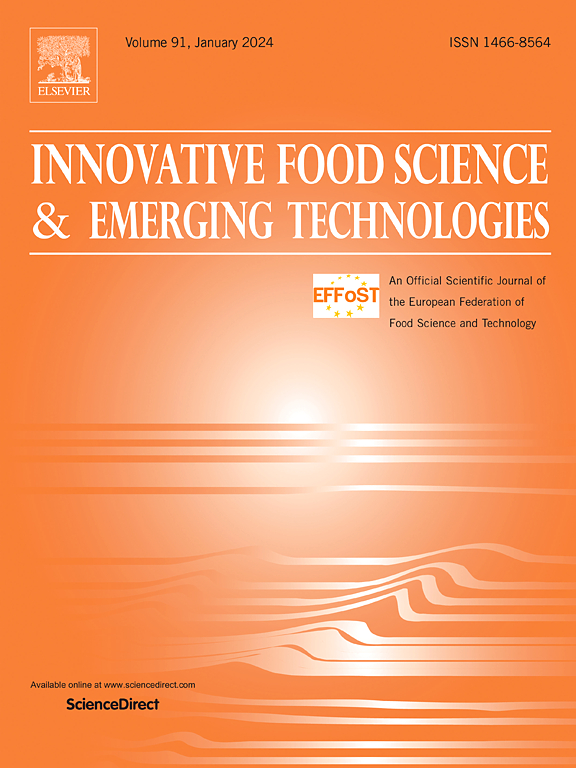Effects of high-pressure homogenization on tea residue mesophyll cell-based Pickering emulsion stabilizers: Property modulation and emulsification enhancement mechanisms
IF 6.3
1区 农林科学
Q1 FOOD SCIENCE & TECHNOLOGY
Innovative Food Science & Emerging Technologies
Pub Date : 2025-07-05
DOI:10.1016/j.ifset.2025.104110
引用次数: 0
Abstract
Collecting tea residue mesophyll cells (TRMCs) pioneers a novel process enabling industrial-scale, cost-effective leaf protein recovery with high yields, surpassing conventional extraction barriers. However, their food applications are constrained by large particle size and poor fluidity, leading to low interfacial adsorption efficiency in emulsions. In this study, high-pressure homogenization (HPH) technology, outperforming airflow ultrafine grinding and ultrasonic crushing, was used to enhance the performance of TRMCs. The effects of different intensities of HPH treatment (100–500 bar for 1–5 min) on the basic composition, microstructure, physicochemical properties, and functional characteristics of TRMCs were investigated, and the underlying mechanism of their emulsification improvement was analyzed. The results showed that HPH treatment only slightly affected basic components (such as protein and total sugar) and the color of TRMCs but significantly reduced the particle size (D(3,2) as low as 5.1 μm). The treatment also eliminated the aggregation and improved the dispersion stability by enhancing electrostatic repulsion. In addition, HPH treatment balanced surface hydrophilicity-hydrophobicity (contact angle increased from 46.6° to 69.2°), exposing hydrophobic domains and more protein and polysaccharide structures, increased the emulsification activity index by 1.3 times, and decreased creaming index by 1.7 times. Unlike traditional Pickering emulsion stabilizers requiring chemical modification or multi-step assembly, HPH-treated TRMCs achieved superior emulsification through synergistic physical fragmentation and chemical group exposure, maintaining natural biocompatibility.

高压均质对茶渣叶肉细胞基Pickering乳液稳定剂的影响:性能调节和乳化增强机制
收集茶渣叶肉细胞(TRMCs)开创了一种新的工艺,使工业规模、高产量、高成本效益的叶蛋白回收成为可能,超越了传统的提取障碍。然而,它们在食品中的应用受到粒径大、流动性差的限制,导致其在乳液中的界面吸附效率较低。在本研究中,采用高压均质(HPH)技术,优于气流超细粉碎和超声波破碎,以提高trmc的性能。研究了不同强度的HPH处理(100-500 bar, 1-5 min)对trmc的基本组成、微观结构、理化性质和功能特性的影响,并分析了其乳化改善的潜在机理。结果表明,HPH处理仅对trmc的基本成分(如蛋白质和总糖)和颜色有轻微影响,但显著降低了trmc的粒径(D(3,2)低至5.1 μm)。该处理还通过增强静电斥力消除了聚合并改善了分散稳定性。此外,HPH处理平衡了表面亲疏水性(接触角从46.6°增加到69.2°),暴露出疏水结构域和更多的蛋白质和多糖结构,乳化活性指数提高了1.3倍,成乳指数降低了1.7倍。与传统的皮克林乳液稳定剂需要化学改性或多步骤组装不同,hph处理的trmc通过协同物理破碎和化学基团暴露获得了优越的乳化效果,保持了天然的生物相容性。
本文章由计算机程序翻译,如有差异,请以英文原文为准。
求助全文
约1分钟内获得全文
求助全文
来源期刊
CiteScore
12.00
自引率
6.10%
发文量
259
审稿时长
25 days
期刊介绍:
Innovative Food Science and Emerging Technologies (IFSET) aims to provide the highest quality original contributions and few, mainly upon invitation, reviews on and highly innovative developments in food science and emerging food process technologies. The significance of the results either for the science community or for industrial R&D groups must be specified. Papers submitted must be of highest scientific quality and only those advancing current scientific knowledge and understanding or with technical relevance will be considered.

 求助内容:
求助内容: 应助结果提醒方式:
应助结果提醒方式:


